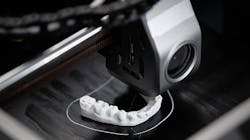Optimizing dental technology for multiple practice locations
We have a lot in common. Besides being women in dentistry, we also both own multiple practices, have a passion for health-care accessibility, and enjoy #farmlife when we’re not working. Additionally, we are both Guiding Leaders alumni and have utilized strategies from the Glidewell program to enhance our leadership and business skills.
It seemed only natural to write an article together about technology across multiple practices. As we both know, owning multiple practices requires organization and efficiency. Simplifying wherever possible, speeding up processes, and improving patient care in sustainable ways are all considerations for practitioners—especially relevant to those who either own multiple practice locations or plan to scale in the future.
The current role of technology in dentistry
Just like every other sector, dentistry has been completely transformed by rapid advancements in technology. It’s truly an exciting time to be in the field, no matter your role. After all, tech is not just for doctors. The day-to-day tasks of hygienists, assistants, receptionists, administrators, and other team members can all be affected by technology.
As a dental practice owner, making sure you choose the right technology is imperative. It is also essential to make sure the appropriate team members are trained to use the technology, which is a continuous process if you’re doing it right. The learning process is never complete because updates are inevitable and new technologies emerge. Keeping an open attitude and hiring team members who share your mindset are keys to having technology be a net positive.
In our view, dental technology should:
Maintain consistency: In dentistry, consistency is of the utmost importance. With technology, we reduce guesswork and come to substantiated conclusions for safer and more predictable results.
Increase productivity: Tech-nol-ogy does not fix poor systems. However, used in a thoughtful way, it can certainly boost productivity through automation, easier access to your patients via text or social media, digital forms, and reduced chair time.
Improve patient experiences: When you educate your patient with visuals they can understand, treatment plan acceptance goes up. Engaging with patients and forming strong relationships are two of the best benefits we see with technology.
Strategies across multiple practices
Though technology is instrumental to any dental practice, multiple practice locations require a higher level of synergy and consideration. There are two main routes you can take when it comes to choosing technology for your practices.
Standardize: If you standardize the technology across your practices, you can more readily send information between locations—e.g., patient records, appointment schedules, etc. This is also relevant if you need to have team members fill in at other locations when absences occur. Floating team members between practices should only happen as needed, but it’s easier if they can jump right in using technology that they’re already familiar with.
Specialize: On the opposite end of the spectrum, you may choose to diversify the technologies at your practices. For example, you may have one location dedicated to in-office milling and another that is all about cosmetics. Instead of generalizing, you can tailor your menu of services to suit the varying needs of your patients. When you own multiple practices, you can give each practice its own marketable identity. Technology reflects those choices.
For most owners, the best strategy is a combination of both. While it makes sense to standardize and integrate all communication between multiple practices, in other areas it makes sense to specialize. Factors you should consider include: the physical distance between your practice locations, the expense of the technology, and your personal bandwidth to manage it. Remember, technology is ultimately supposed to simplify your workflow, not make it more difficult.
The technology that’s helped us
With one of us being a doctor and the other being a hygienist, we have varied perspectives. As owners, however, we have so much in common. At the end of the day, our patients are the center of our worlds—everything we do is for them. As a result, we end up being very hands-on and spending a lot of time in our practices.
When you take pride in what you do, it’s difficult to delegate as much as you should, especially when people are relying on you for answers on everything from purchasing to compliance. Additionally, there are always external challenges that arise, such as staff shortages.
Both of us have found technology that has eased our stress, improved our patient experiences, and given us the ability to achieve long-term business success. We love what we do, and we are optimistic about the future of digital dentistry. Here are some of the items we count on as multipractice owners:
In-office mills: We both use the fastmill.io In-Office Mill (Glidewell), which allows us to produce same-day crowns. Patients are impressed that they need fewer appointments and get to enjoy their new smiles faster. Plus, the direct support from Glidewell means we never have to worry.
Intraoral cameras: We both agree that high-quality intraoral imaging has been one of the most important advancements in dentistry. It helps us make more informed decisions and serves as a powerful tool for patient education. When the patient can see exactly what’s going on in their own mouth, they’re more open to accepting your treatment plan.
CBCT scans: CBCT scans can diagnose conditions such as caries, impacted wisdom teeth, fractures, cysts, and restorative failures. In areas that are difficult to examine, we can see detailed 3D imaging.
AI-enabled x-ray analysis: Software such as Overjet, Pearl, and Dentrix Detect AI offer enhanced x-rays that are highlighted in color and detail for an annotation effect that is relatively new to dentistry.
Cloud-based practice management software: In 2024 every practice should be using cloud-based software. To be able to access what you need from anywhere is so important, especially in a multipractice setting. There are plenty of software options, but there are companies that specifically focus on integration for multiple locations, such as Patterson Dental.
Your future
If you’re ready to expand your practice—whether you are a multipractice owner or looking to become one—the best way to achieve growth is by integrating new technology. All technology comes with a learning curve, so having an open mind and a staff that is willing to join you on the journey is the most important first step. Researching, checking in with your network, and experimenting are all part of finding what works for you. We hope you’ll make a commitment to yourself and your patients to respond to innovations and help create an amazing future in dentistry.
Editor's note: The article appeared in the September print edition of Dental Economics magazine. Dentists in North America are eligible for a complimentary print subscription. Sign up here.
About the Author

Lan Chi Le, DDS
Lan Chi Le, DDS, is the founder, sole owner, and CEO of ZYGO Dental Group, a pioneering venture that currently manages nine practices and oversees approximately 60 employees in Texas. Dr. Le’s innovative approach includes the establishment of dental clinics inside Walmart Supercenters. She has collaborated with the retail giant on six locations and counting, enhancing accessibility and affordability for high-barrier customers. Dr. Le also serves as a mentor for aspiring dentists and health-care professionals.

Liz Miller, RDH
Liz Miller, RDH, is a dedicated dental hygienist with more than two decades of experience. She currently owns two independent practices in Parker, Colorado—Healthy Smiles Shine LLC and Progressive Dental Health. In 2015, she introduced mobile care for assisted living and disabled patients, as well as families in rural Colorado. She continuously drives accessibility initiatives in her community to promote oral health for all.

